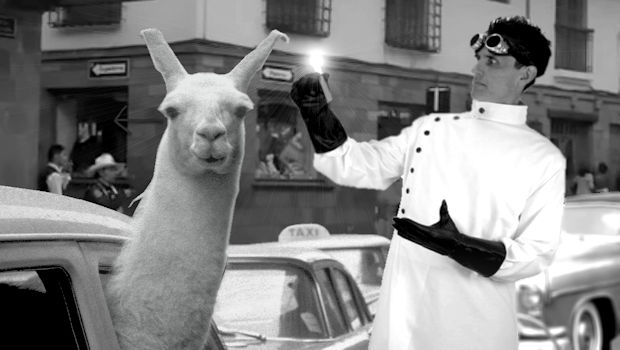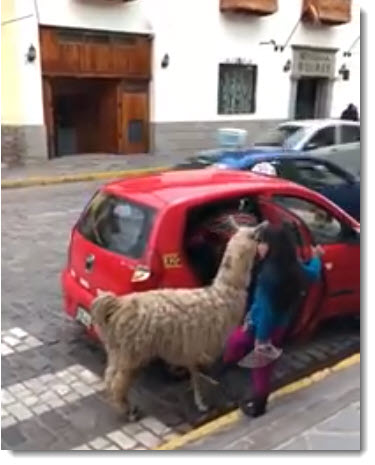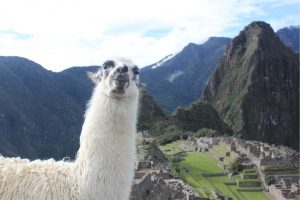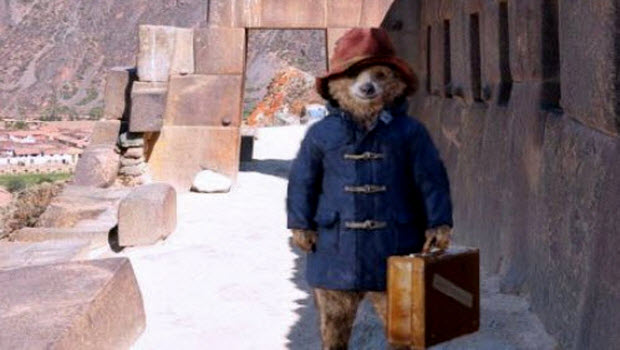
7 Things You Should Know About the Peruvian Llama
Perhaps you’ve seen this recent viral video of a Peruvian llama climbing adeptly into a taxi in Cusco.
Pretty impressive!
But, besides their apparent ability to hop into vehicles, what other interesting facts about llamas did you not know about llamas in Peru? We’ve got a few quick, fascinating facts for you.
7 Interesting Facts about the Peruvian Llama
1. Llamas may be the key to fighting the flu.
Yes, you heard that right. According to the recent articles, scientists have been able to use antibodies from llamas to fight a much wider variety of flu strains, and even possible pandemics, than human antibodies can.
2. Llamas were the most important domestic animal in the Inca Empire.
Peruvian llamas were used as pack animals to transport goods throughout the vast empire, and their dung was commonly used as fertilizer. The British Museum houses a small gold model of a llama believed to have been buried as a sacrifice to the Inca mountain god.
3. What is the difference between llamas and alpacas
It’s easy to confuse llamas and alpacas (and their cousins, vicuñas), but there are a few key differences. You can distinguish an alpaca from a llama by its pointier ears, fuzzier face, and smaller size. Bonus fact: Alpacas, llamas, and vicuñas are all related to camels.
4. Llamas spit at other animals when threatened or angered.
Be careful with this one if you ever cross paths with a llama! Llamas are known for spitting to show displeasure or irritation, and if you mistreat or upset a llama, you may get sprayed. Don’t believe us?
5. Llamas were considered very exotic when first discovered by Europeans.
After his first encounter with the Incan Empire, Francisco Pizarro sailed back to Spain to show King Carlos V what he had found. Pizarro showed him the beautiful, intricate silver and gold workings of the Inca, but it’s reported that what truly captivated the king was the llamas Pizarro had brought back from the “New World.” Where do llamas live now? All over. Europe, the United States, Canada, Asia.
6. Llamas can run at speeds of up to 35 miles per hour.
We usually think of llamas as very tranquil animals who sit around chewing cud, but llamas are quite athletic. If a llama wants to get somewhere in a hurry, it can certainly do so, with top speeds of up to 35 miles per hour!
7. Llamas are not camera shy!
At least, anecdotal evidence seems to point to that. There are plenty of llamas who graze on the pristine grounds at Machu Picchu, and they always seem to cooperate with tourists for a nice photo.
Related:
Want to know how to spot a fake alpaca blanket or sweater? Click HERE to learn the difference between Baby Alpaca and Maybe Alpaca!


 Spooky Pre-Halloween Sighting By Security Patrol in Peru
Spooky Pre-Halloween Sighting By Security Patrol in Peru  Vargas Llosa and other celebrity sightings at Machu Picchu so far in 2017
Vargas Llosa and other celebrity sightings at Machu Picchu so far in 2017  How To Celebrate New Years Eve in Peru for guaranteed great time?
How To Celebrate New Years Eve in Peru for guaranteed great time?  Manu Family Vacation and an Actor’s Tribute to Roger Corman
Manu Family Vacation and an Actor’s Tribute to Roger Corman  Peru 2016 holiday calendar – Download
Peru 2016 holiday calendar – Download  Mr. Monopoly Tours Lima in Search of Votes
Mr. Monopoly Tours Lima in Search of Votes  Paddington Bear’s Peru Tour includes COP20 appearance
Paddington Bear’s Peru Tour includes COP20 appearance  Wonder Woman’s magic bracelets re-imagined by real life heroine from Cusco
Wonder Woman’s magic bracelets re-imagined by real life heroine from Cusco